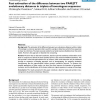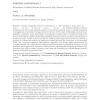286 search results - page 8 / 58 » The Distribution of Genomic Distance between Random Genomes |
BMCBI
2006
13 years 7 months ago
2006
Background: Genome sequences vary strongly in their repetitiveness and the causes for this are still debated. Here we propose a novel measure of genome repetitiveness, the index o...
BMCBI
2006
13 years 7 months ago
2006
Background: The estimation of the difference between two evolutionary distances within a triplet of homologs is a common operation that is used for example to determine which of t...
BMCBI
2007
13 years 7 months ago
2007
Background: The question of how a circle or line segment becomes covered when random arcs are marked off has arisen repeatedly in bioinformatics. The number of uncovered gaps is o...
STOC
1995
ACM
13 years 11 months ago
1995
ACM
Genomes frequently evolve by reversals (i, j) that transform a gene order 1 . . . iiϩ1 . . . jϪ1j . . . n into 1 . . . ijϪ1 . . . iϩ1j . . ....
BMCBI
2006
13 years 7 months ago
2006
Background: Analysis of genomes evolving via block-interchange events leads to a combinatorial problem of sorting by block-interchanges, which has been studied recently to evaluat...


